Multiple Sclerosis Therapeutics Market Size
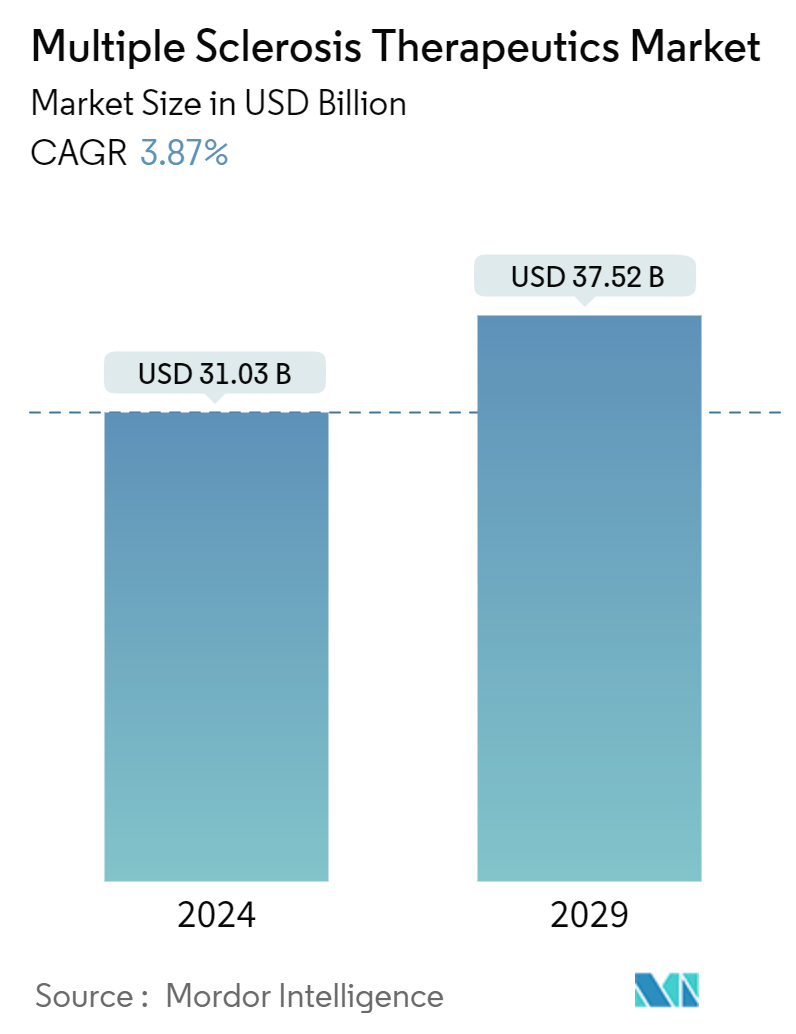
| Study Period | 2019 - 2029 |
| Market Size (2024) | USD 31.03 Billion |
| Market Size (2029) | USD 37.52 Billion |
| CAGR (2024 - 2029) | 3.87 % |
| Fastest Growing Market | Asia Pacific |
| Largest Market | North America |
Major Players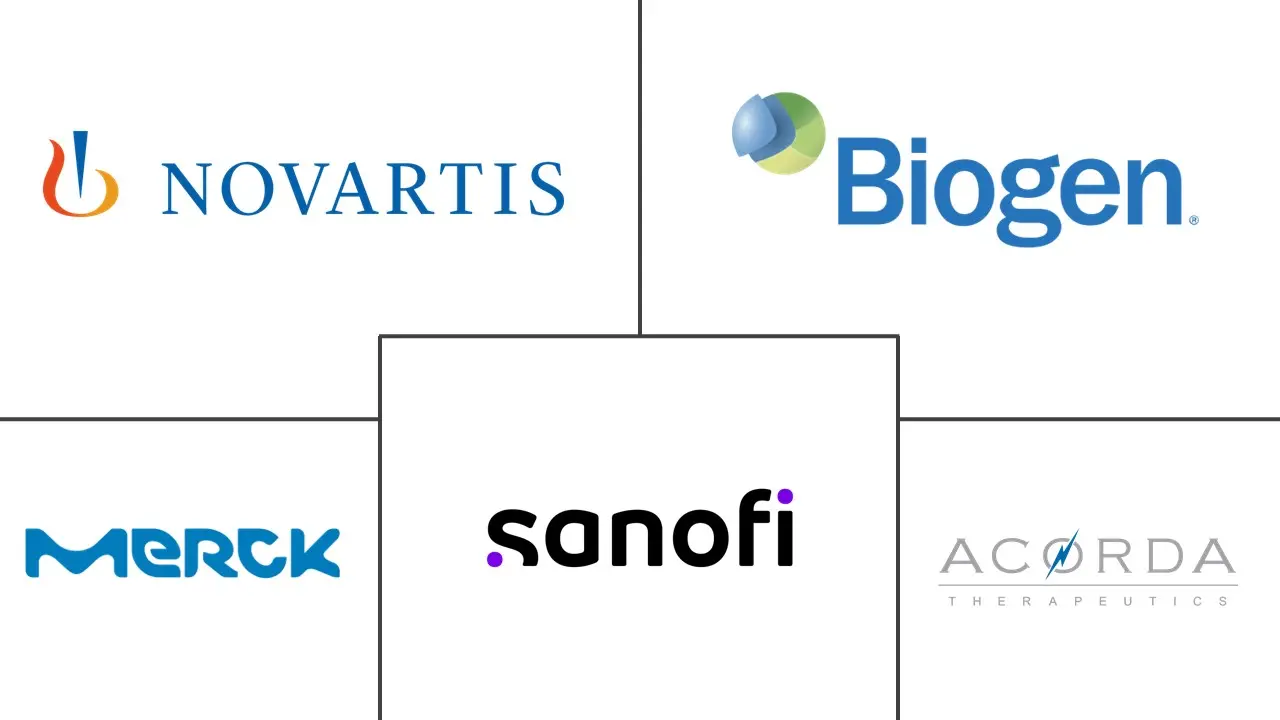
*Disclaimer: Major Players sorted in no particular order |
Multiple Sclerosis Therapeutics Market Analysis
The Multiple Sclerosis Therapeutics Market size is estimated at USD 31.03 billion in 2024, and is expected to reach USD 37.52 billion by 2029, growing at a CAGR of 3.87% during the forecast period (2024-2029).
The COVID-19 pandemic significantly impacted the healthcare systems, affecting not only patients infected with COVID-19 but also others, resulting in disruptions in research and development activities for other therapies, including MS therapy, during the initial COVID-19 outbreak. Due to the strain on healthcare systems and concerns about virus transmission, some MS patients faced delays in diagnosis and treatment. Routine check-ups, imaging studies, and elective procedures were postponed, potentially affecting the early management of the disease. For instance, according to the article published in June 2022 in the Current Neurology and Neuroscience Report, there were significant delays in the diagnosis and treatment of MS. These were delays in infusions to minimize potential COVID-19 exposure, and only about half of these delays were advised by the patient’s health care providers. However, the market recovered well post-pandemic due to the introduction of advanced patient management solutions across healthcare facilities. The market is projected to witness high growth opportunities owing to the escalating burden of conditions and rising R&D efforts by pharmaceutical companies.
The market studied is expected to witness a rapid growth rate in the future, owing to factors such as the rise in the prevalence of multiple sclerosis (MS), an increase in research and development, and product launches by the key players. For instance, according to data from the National Multiple Sclerosis Society UK Report published in May 2022, over 130,000 people are living with multiple sclerosis (MS) in the United Kingdom, and every year, around 7,000 people are diagnosed with multiple sclerosis in the country. Thus, this escalating burden of multiple sclerosis is projected to provide lucrative growth opportunities for the market over the forecast period.
Moreover, key pharmaceutical companies are investing heavily in the drug development process, so MS therapeutics. They are planning to target as many indications as possible to cater to many customers. For instance, in October 2023, the FDA approved Tiziana Life Sciences’ drug candidate foralumab, a fully human intranasal anti-CD3 monoclonal antibody, to be taken at home and self-administered for the treatment of patients living with multiple sclerosis (MS). Furthermore, extended applications for MS drugs are one of the major factors boosting the adoption of the drug. For instance, in February 2022, Teva Pharmaceuticals Europe BV confirmed that the SmPC for COPAXONE (Glatiramer Acetate (GA) injection) 20mg/mL and 40mg/mL, indicated for the treatment of relapsing forms of multiple sclerosis (RMS) in Europe. The product is now approved by European Union (EU) health authorities for use in breastfeeding. Thus, the recent product approvals and increased efforts by pharmaceutical companies to develop novel therapeutics are driving market expansion.
Additionally, an increase in research funding, grants, and other investments for the development of multiple sclerosis research is projected to fuel the market growth over the forecast period. For instance, in February 2023, scientists from Menzies School of Health Research received grants, bringing a combined total of USD 818,966 to their MS Research Flagship. MS Research Flagship’s vision is to lower the impact of multiple sclerosis (MS) on individuals and the community.
Thus, owing to the increase in MS prevalence coupled with various organic and inorganic activities of the key players, the market is expected to project growth over the forecast period. However, side effects associated with medications and the high cost of drugs may hinder the growth of the market.
Multiple Sclerosis Therapeutics Market Trends
The Oral Route of Administration is Expected to Witness Rapid Growth in Over the Forecast Period
The oral route of administration segment is expected to witness significant growth in the studied market owing to advantages like patient satisfaction and increased therapeutic compliance with the oral route of administration compared to other routes. Further, a rise in product launches and approvals for drugs targeting MS in the form of tablets or capsules is likely to fuel market growth. For instance, in June 2022, Amneal Pharmaceuticals, Inc. launched LYVISPAH, a United States FDA-approved granules (5, 10 and 20 mg) for the management of spasticity related to multiple sclerosis (MS) and other spinal cord disorders. This launch helped the company to bolster its neurological disorders therapies in the United States market.
Also, in June 2022, Sandoz expanded its portfolio with the launch of the generic drug Dimethyl fumarate HEXAL, which was approved for the treatment of adults with relapsing-remitting multiple sclerosis (RRMS) in Germany. Dimethyl fumarate HEXAL enteric-coated hard capsules are a cost-effective alternative in the treatment of adult patients with multiple sclerosis compared to the reference medicine Tecfidera. Thus, the rising product approvals and introduction of novel oral therapeutics for managing multiple sclerosis are pushing segment expansion.
Furthermore, an increase in pipeline studies and their developments in MS are likely to contribute to market growth. For instance, in June 2022, Bristol Myers Squibb publicized posthoc analyses from the Zeposia (ozanimod) Phase 3 DAYBREAK open-label extension (OLE) and Phase 3 SUNBEAM trials, showing early Zeposia use demonstrated cognitive benefits in patients with relapsing multiple sclerosis (MS), with the greatest effect seen in people with high thalamic volume (TV), supporting an association between preserved brain volume (BV) and the enhanced long-term cognitive outcomes. These data were presented at the European Academy of Neurology (EAN) Congress. Such positive outcomes in clinical trials and expected launches in the next 2-3 years are projected to contribute to segment expansion.
Therefore, owing to the increase in product launches, approvals, and other strategic activities by the key players coupled with the increase in clinical studies in MS, the studied segment is expected to augment the demand of the studied market over the forecast period.
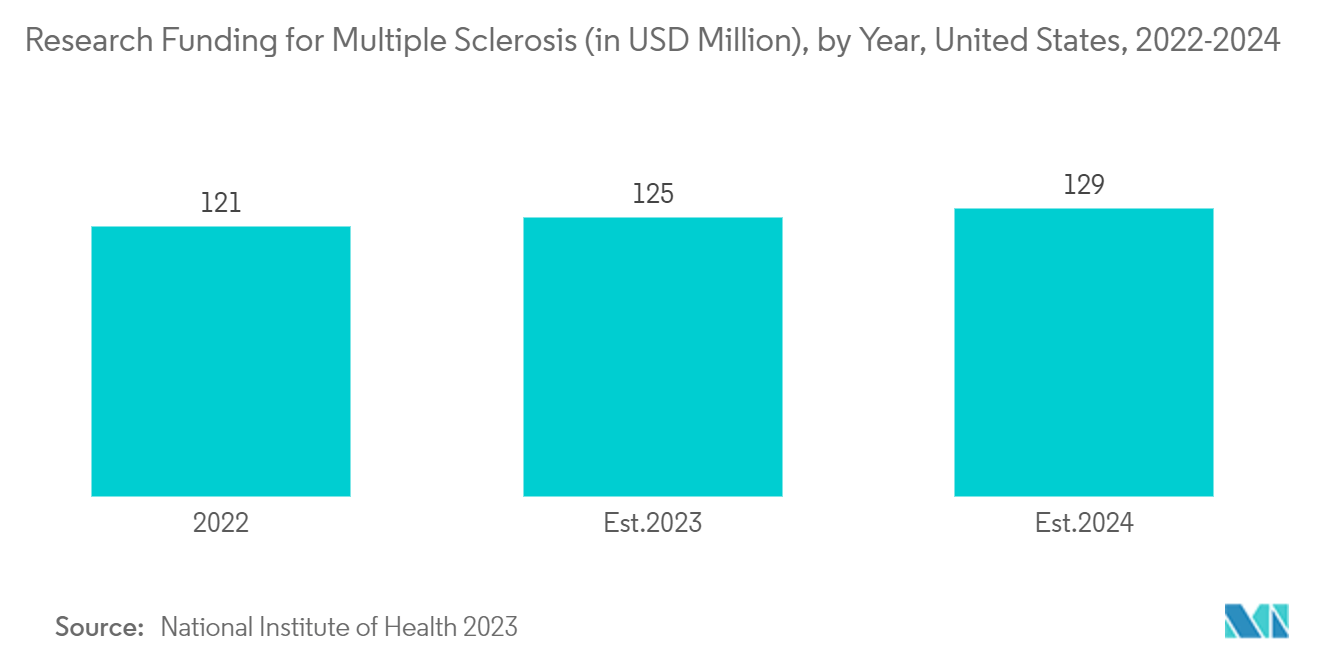
North America is Expected to Hold a Significant Share in the Market and Expected to do Same Over the Forecast Period
The market for multiple sclerosis therapeutics is expected to show healthy growth in the North American region, which is majorly attributed to the rising prevalence of multiple sclerosis and the presence of key players focusing on the MS pipeline. Furthermore, an increase in research funding and a rise in research activities for the treatment of MS are also expected to bolster market growth. For instance, according to the Multiple Sclerosis Association America May 2022 update, nearly one million individuals are living with MS in the United States.
Additionally, the presence of the key market player, the rise in product launches, and the approval by the regulatory authorities are also propelling the growth of the market. For instance, in December 2022, TG Therapeutics received U.S. FDA approval for BRIUMVI (ublituximab-xiiy) as a treatment for patients with relapsing forms of multiple sclerosis (RMS).BRUUMVI can be given as an injection or IV solution. Moreover, in December 2022, the United States Food and Drug Administration (FDA) approved BRIUMVI (ublituximab-xiiy) for treating relapsing forms of multiple sclerosis (MS). It is one of the first anti-CD20 monoclonal antibodies approved in the U.S. for relapsing MS patients. BRIUMVI can be given in a one-hour infusion after the initial four-hour dose. It’s indicated for the clinically isolated syndrome, relapsing-remitting disease, and active secondary progressive disease in adults.
In addition, the surge in research grants and supportive legislation is further contributing to the regional market growth. For instance, in November 2023, the National Multiple Sclerosis Society invested USD 4.4 million in new research projects, aligning with their strategy to guide global MS research toward promising areas outlined in the Pathways to Cures roadmap. This commitment is part of an annual investment exceeding USD 30 million in over 200 MS research studies worldwide.
Furthermore, increasing collaboration between drug companies and governments to widen access to multiple sclerosis treatment is another factor fueling regional market growth. For instance, in April 2022, Novartis Pharmaceuticals Canada Inc. announced that Kesimota (ofatumumab) is covered under the Ontario Exceptional Access Program (EAP) and included on the Régie de l'assurance maladie du Québec (RAMQ) List of Medications as an Exceptional Medication for treating adults with relapsing-remitting multiple sclerosis (RRMS) with active disease features. This development improves access to an effective treatment option for eligible patients in Quebec and Ontario, allowing them to manage their disease safely and conveniently at home. This advancement provides RRMS patients meeting therapeutic criteria with a choice that addresses the need to reduce relapse risk and slow progression while offering flexibility in their lives.
Thus, owing to the increase in product launches, approvals, and other strategic activities by the key players, coupled with the increase in the prevalence of MS in the North American region, is expected to bolster the demand of the studied market over the forecast period.
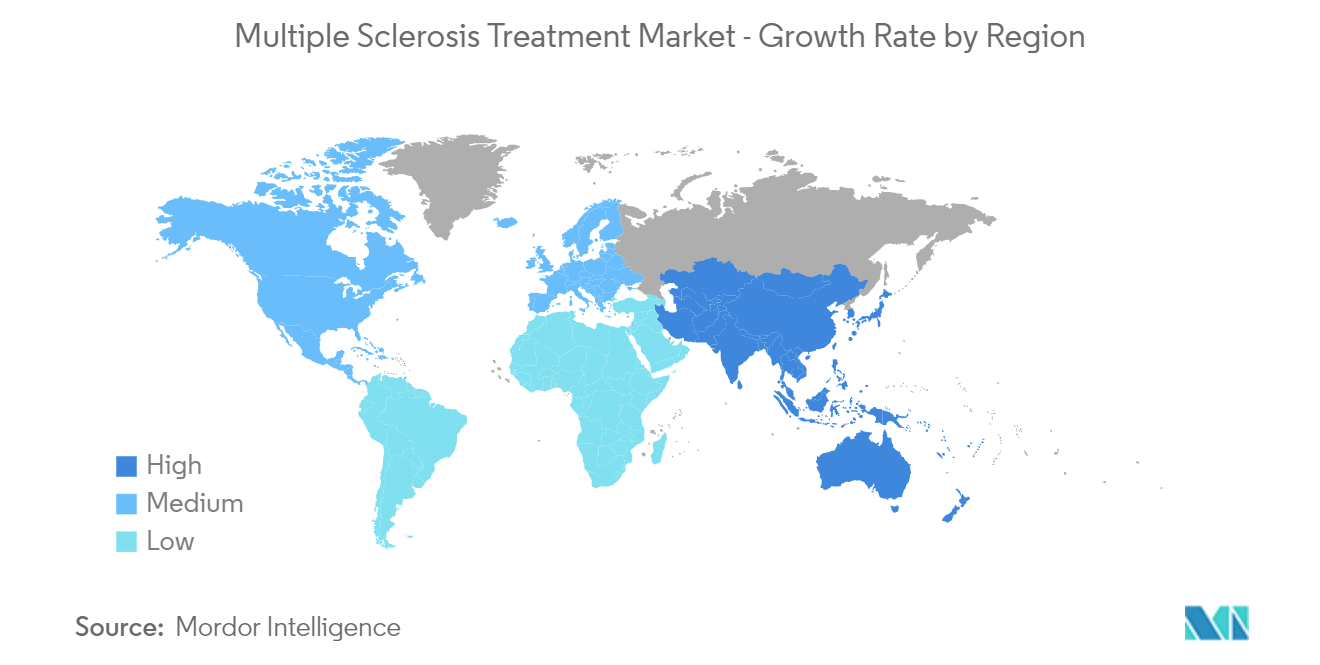
Multiple Sclerosis Therapeutics Industry Overview
The multiple sclerosis therapeutics market is moderately competitive, as there are few players in this market. These companies are the big pharmaceutical companies focusing on pipeline drugs for multiple sclerosis. With the rising R&D investment in the pharmaceutical industry, it is believed that more companies may enter the market studied in the future, and the competition may increase. A few of the major companies currently dominating the market are Biogen Inc., Novartis AG, Merck KGaA, Sanofi, and Acorda Therapeutics, Inc., among others.
Multiple Sclerosis Therapeutics Market Leaders
-
Biogen Inc.
-
Novartis AG
-
Merck KGaA
-
Sanofi S. A.
-
Acorda Therapeutics, Inc.
*Disclaimer: Major Players sorted in no particular order
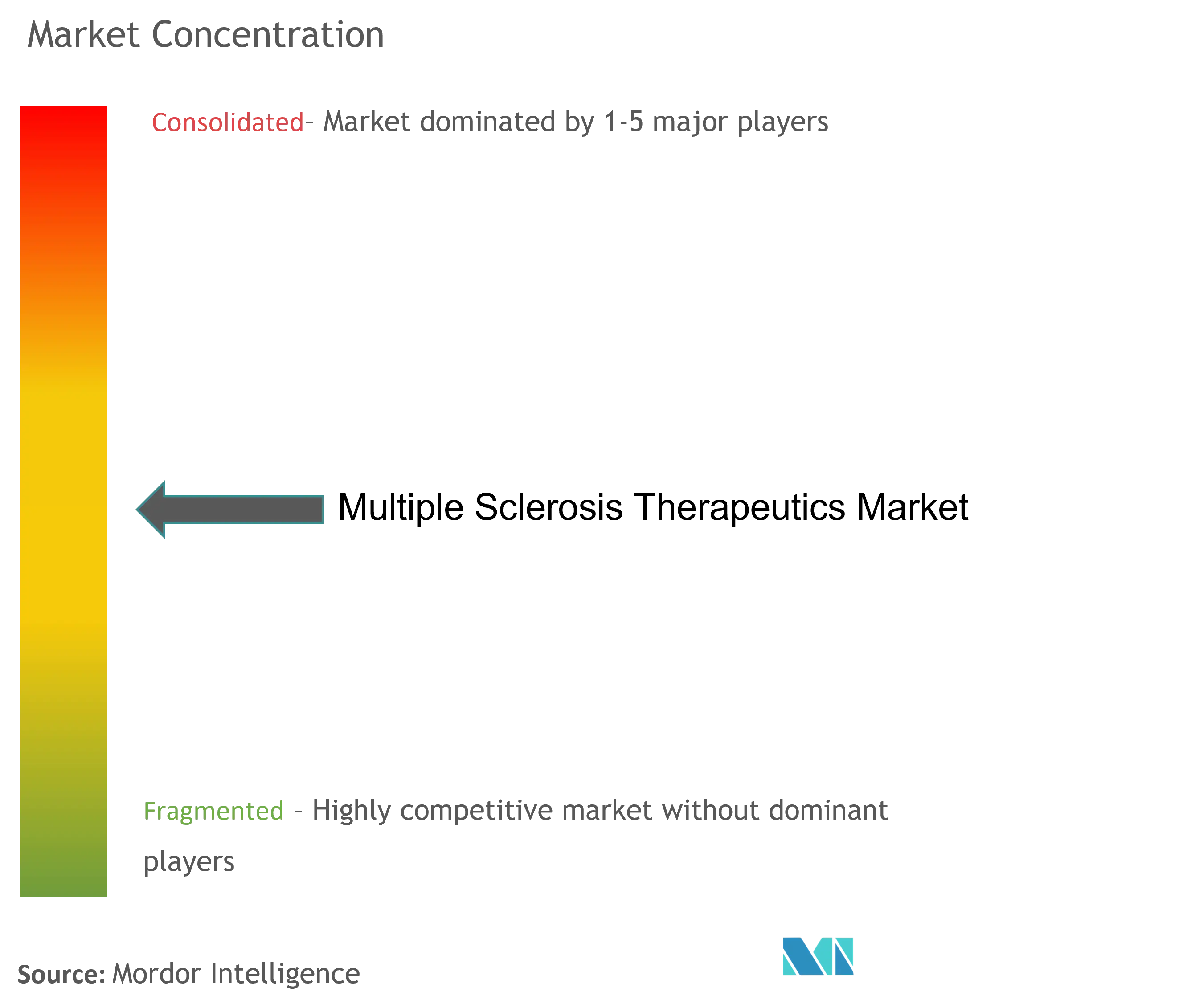
Multiple Sclerosis Therapeutics Market News
- October 2023: Bristol Myers Squibb presented Zeposia's (ozanimod) data on long-term disease progression and cognition in patients with relapsing forms of multiple sclerosis (MS). 76% of patients treated with Zeposia for relapsing multiple sclerosis (RMS) were free of six-month confirmed disability progression (CDP).
- September 2023: Sandoz received the European Commission (EC) marketing authorization for biosimilar Tyruko (natalizumab) for multiple sclerosis. The US FDA approved the same product in August 2023.
Multiple Sclerosis Therapeutics Market Report - Table of Contents
1. INTRODUCTION
- 1.1 Study Assumptions and Market Definition
- 1.2 Scope of the Study
2. RESEARCH METHODOLOGY
3. EXECUTIVE SUMMARY
4. MARKET DYNAMICS
- 4.1 Market Overview
-
4.2 Market Drivers
- 4.2.1 Rising Cases of Multiple Sclerosis across the World
- 4.2.2 Growing Focus of Companies on Pipeline Products for MS
-
4.3 Market Restraints
- 4.3.1 Side Effects Associated with the Medication
- 4.3.2 High Cost of the Drugs
-
4.4 Porter's Five Forces Analysis
- 4.4.1 Bargaining Power of Suppliers
- 4.4.2 Bargaining Power of Buyers/Consumers
- 4.4.3 Threat of New Entrants
- 4.4.4 Threat of Substitute Products
- 4.4.5 Intensity of Competitive Rivalry
5. MARKET SEGMENTATION (Market Size by Value – USD)
-
5.1 By Drug Type
- 5.1.1 Large-molecule Drugs
- 5.1.2 Small-molecule Drugs
-
5.2 By Route of Administration
- 5.2.1 Oral
- 5.2.2 Injectable and Other routes of administration
-
5.3 Geography
- 5.3.1 North America
- 5.3.1.1 United States
- 5.3.1.2 Canada
- 5.3.1.3 Mexico
- 5.3.2 Europe
- 5.3.2.1 Germany
- 5.3.2.2 United Kingdom
- 5.3.2.3 France
- 5.3.2.4 Italy
- 5.3.2.5 Spain
- 5.3.2.6 Rest of Europe
- 5.3.3 Asia-Pacific
- 5.3.3.1 China
- 5.3.3.2 Japan
- 5.3.3.3 India
- 5.3.3.4 Australia
- 5.3.3.5 South Korea
- 5.3.3.6 Rest of Asia-Pacific
- 5.3.4 Middle East and Africa
- 5.3.4.1 GCC
- 5.3.4.2 South Africa
- 5.3.4.3 Rest of Middle East and Africa
- 5.3.5 South America
- 5.3.5.1 Brazil
- 5.3.5.2 Argentina
- 5.3.5.3 Rest of South America
6. COMPETITIVE LANDSCAPE
-
6.1 Company Profiles
- 6.1.1 Teva Pharmaceuticals Industries Ltd.
- 6.1.2 Novartis AG
- 6.1.3 Bristol-Myers Squibb Company
- 6.1.4 Biogen
- 6.1.5 Bayer AG
- 6.1.6 Sanofi SA
- 6.1.7 Viatris Inc. (Mylan NV)
- 6.1.8 Merck KGaA
- 6.1.9 F. Hoffmann-La Roche AG
- 6.1.10 Acorda Therapeutics Inc.
- 6.1.11 Johnson & Johnson
- *List Not Exhaustive
7. MARKET OPPORTUNITIES AND FUTURE TRENDS
** Subject To AvailablityMultiple Sclerosis Therapeutics Industry Segmentation
As per the scope of the report, multiple sclerosis (MS) involves an immune-mediated process in which an abnormal response of the body’s immune system is directed against the central nervous system (CNS). The multiple sclerosis therapeutics market is segmented by drug type (small molecule drugs, large molecule drugs), route of administration (oral, injectable, and other routes of administration), and geography (North America, Europe, Asia-Pacific, Middle East and Africa, and South America). The market report also covers the estimated market sizes and trends for 17 countries across major global regions. The report offers the value (USD) for the above segments.
| By Drug Type | Large-molecule Drugs | |
| Small-molecule Drugs | ||
| By Route of Administration | Oral | |
| Injectable and Other routes of administration | ||
| Geography | North America | United States |
| Canada | ||
| Mexico | ||
| Geography | Europe | Germany |
| United Kingdom | ||
| France | ||
| Italy | ||
| Spain | ||
| Rest of Europe | ||
| Geography | Asia-Pacific | China |
| Japan | ||
| India | ||
| Australia | ||
| South Korea | ||
| Rest of Asia-Pacific | ||
| Geography | Middle East and Africa | GCC |
| South Africa | ||
| Rest of Middle East and Africa | ||
| Geography | South America | Brazil |
| Argentina | ||
| Rest of South America |
Multiple Sclerosis Therapeutics Market Research FAQs
How big is the Multiple Sclerosis Therapeutics Market?
The Multiple Sclerosis Therapeutics Market size is expected to reach USD 31.03 billion in 2024 and grow at a CAGR of 3.87% to reach USD 37.52 billion by 2029.
What is the current Multiple Sclerosis Therapeutics Market size?
In 2024, the Multiple Sclerosis Therapeutics Market size is expected to reach USD 31.03 billion.
Who are the key players in Multiple Sclerosis Therapeutics Market?
Biogen Inc., Novartis AG, Merck KGaA, Sanofi S. A. and Acorda Therapeutics, Inc. are the major companies operating in the Multiple Sclerosis Therapeutics Market.
Which is the fastest growing region in Multiple Sclerosis Therapeutics Market?
Asia Pacific is estimated to grow at the highest CAGR over the forecast period (2024-2029).
Which region has the biggest share in Multiple Sclerosis Therapeutics Market?
In 2024, the North America accounts for the largest market share in Multiple Sclerosis Therapeutics Market.
What years does this Multiple Sclerosis Therapeutics Market cover, and what was the market size in 2023?
In 2023, the Multiple Sclerosis Therapeutics Market size was estimated at USD 29.83 billion. The report covers the Multiple Sclerosis Therapeutics Market historical market size for years: 2019, 2020, 2021, 2022 and 2023. The report also forecasts the Multiple Sclerosis Therapeutics Market size for years: 2024, 2025, 2026, 2027, 2028 and 2029.
Multiple Sclerosis Therapeutics Industry Report
The Multiple Sclerosis Treatment Market Report provides a comprehensive industry analysis, focusing on various aspects of the market, including market segmentation by drug type, route of administration, and geography. This industry report offers valuable market data and industry statistics, highlighting the market size and market value of the Multiple Sclerosis Therapeutics sector. The report also includes a market forecast, giving an industry outlook and market predictions up to the forecast period.
The industry research encompasses both large-molecule and small-molecule drugs, with further segmentation by oral, injectable, and other routes of administration. Geographical coverage includes North America, Europe, Asia-Pacific, Middle East and Africa, and South America, providing a detailed industry overview and market review for each region.
Key market trends and industry trends are analyzed, offering insights into the market growth and growth rate of the Multiple Sclerosis Therapeutics market. The report also identifies market leaders and provides a market overview, outlining the competitive landscape and market segmentation.
For those interested in detailed industry information, the report includes a sample of the industry analysis as a free report PDF download. This report example offers a snapshot of the comprehensive research conducted by Mordor Intelligence™ Industry Reports. The market research includes an analysis of market growth, market outlook, and industry sales, ensuring a thorough understanding of the market dynamics.
In summary, this report is an essential resource for research companies and stakeholders in the Multiple Sclerosis Treatment Market, providing in-depth industry reports, market forecast, and industry sales data. The report's industry information and market predictions make it a valuable tool for understanding the current and future state of the market.



